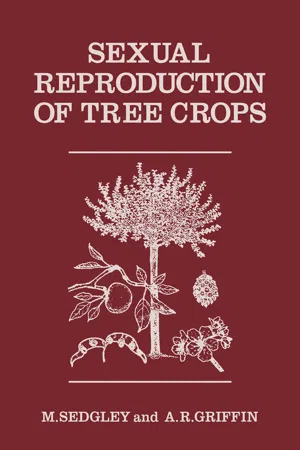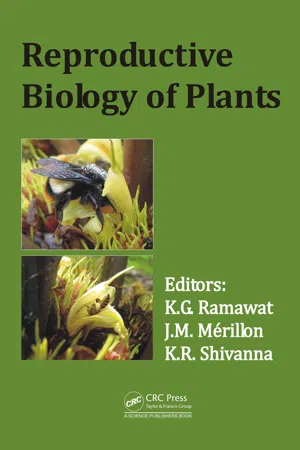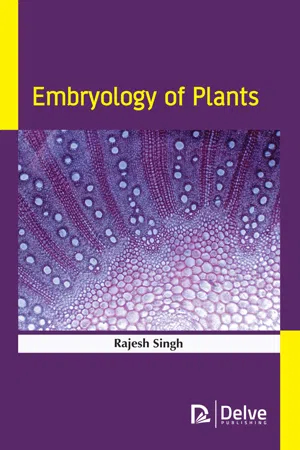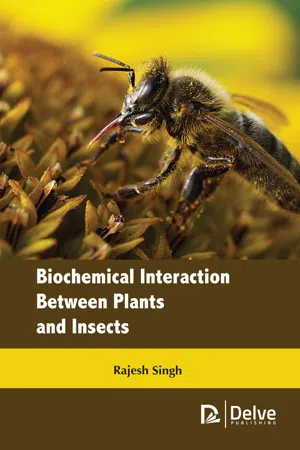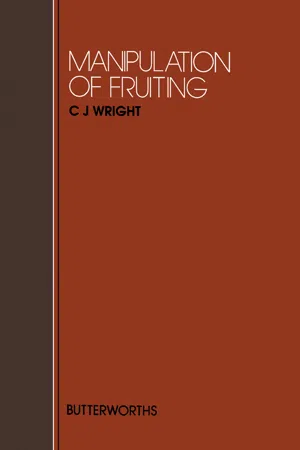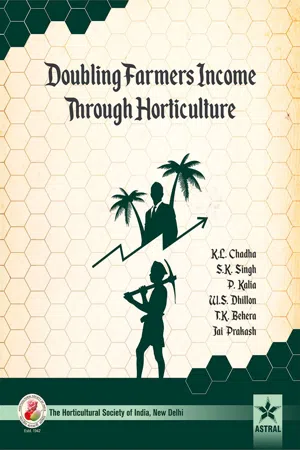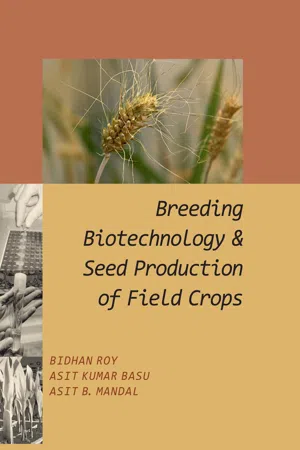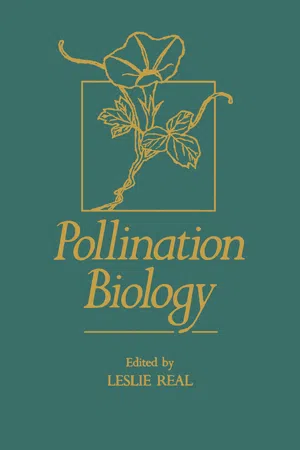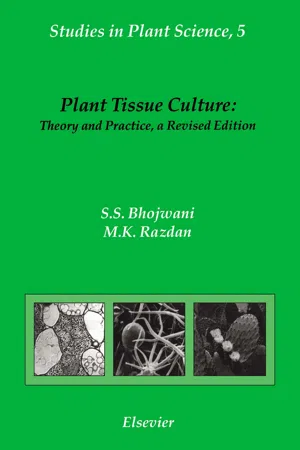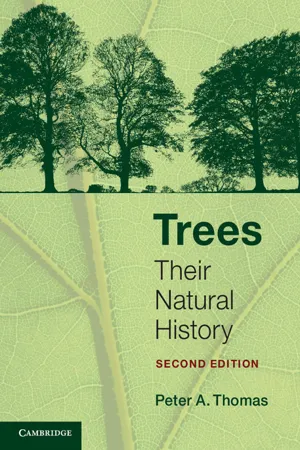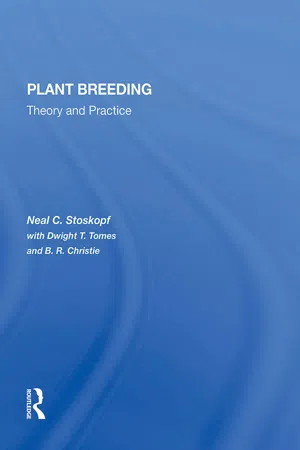Biological Sciences
Pollination
Pollination is the process by which pollen is transferred from the male reproductive organs of a flower to the female reproductive organs, leading to fertilization and the production of seeds. This transfer can occur through various agents such as wind, water, insects, birds, or other animals. Pollination is essential for the reproduction of flowering plants and the maintenance of biodiversity.
Written by Perlego with AI-assistance
Related key terms
1 of 5
12 Key excerpts on "Pollination"
- eBook - PDF
- M. Sedgley, A.R. Griffin(Authors)
- 2013(Publication Date)
- Academic Press(Publisher)
4 Pollination 4.1 I N T R O D U C T I O N Pollination—the transfer of pollen from male reproductive structures to receptive stigmas or micropyles—is the first male/female interactive step in the reproductive process. In the previous chapters we have been mainly concerned with the flowering characteristics of individual plants, but for effective management of Pollination it is also necessary to understand the functioning of the crop as a population, or indeed in the case of biotically pollinated species, as an even more complex ecological system. For the growers of ornamental tree species, or of a few other crops such as clove, the flower itself is the desired product and Pollination is of little consequence. However, for the great majority of fruit and tree seed crops Pollination is of critical importance. The aim of Pollination management is simply to ensure that transfer of pollen of appropriate genotype(s) is adequate to produce the optimal quantity and quality of fruit or seed. Opportunities to influence the success of Pollination lie mainly in the choice of orchard environment, the prescription of the genotypes and spatial arrangement of orchard trees and the manipulation of vector populations. - eBook - PDF
- Kishan Gopal Ramawat, Jean-Michel Merillon, K. R. Shivanna, Kishan Gopal Ramawat, Jean-Michel Mérillon, K. R. Shivanna, Jean-Michel Merillon(Authors)
- 2016(Publication Date)
- CRC Press(Publisher)
Pollination is the only means of gene flow between conspecific plants and populations, and is thus the basis of recombination. Successful Pollination is a prerequisite for fruit and seed development, and thus plays an important role in reproductive success of both cultivated and wild plant species. Pollination limitation reduces the yield of cultivated species (Roubik 1995; Knight et al. 2005; James and Pitts-Singer 2008) and often acts as a driving force for species vulnerability in natural habitats (Spira 2001; Wilcock and Neiland 2002; Biesmeijer et al. 2006; Potts et al. 2009; Shivanna 2012a; Burkle et al. 2013; Tylianakis 2013). Information on Pollination ecology is essential for the release of genetically transformed plants (Armstrong et al. 2005). Pollination services are needed to sustain pollinators particularly those that depend exclusively on floral resources (nectar/pollen). 220 Reproductive Biology of Plants Pollination is simply the deposition of pollen grains from an anther to the stigma. Based on the source of pollen, Pollination is of three types: i) autogamy: transfer of pollen grains from the anthers to the stigma of the same flower, ii) geitonogamy: transfer of pollen grains from the anthers to the stigma of another flower of the same plant or another plant of the same clone and iii) xenogamy: transfer of pollen grains from the anther to the stigma of another non-clonal plant. Sexuality of the flower and of the plant affects pollen flow within and between flowers/plants. The flowers may be hermaphrodite (producing both functional pollen and ovules) or male (producing only functional pollen) or female (producing only functional ovules). The plant may be bisexual (producing only hermaphrodite flowers) or monoecious (each plant producing both male and female flowers) or dioecious (each plant producing only male or only female flowers). - eBook - PDF
- Rajesh Singh(Author)
- 2020(Publication Date)
- Delve Publishing(Publisher)
In addition to this, the flower-visiting behavior, which is the result obtained, would affect the seed yield as well as the quality. There is a direct relation in between the Pollination efficiency and the Pollination amount and quality. This is affected by flower - visiting behavior. Thus, the interaction among population structure, Pollination efficiency and Pollination behavior is considered to be very complex and furthermore, requires synthetic as well as meticulous research. 5.2. Pollination: A GENERAL OVERVIEW Pollination is considered to be the process of transferring the pollen grains from the anther to the stigma. Anther is the male part of the flower and stigma is the female part. This is the process which normally precedes fertilization. It is considered to be an important process in the reproduction of plants and this is the process without which sexual reproduction will not take place. Embryology of Plants 124 Over the ages, Pollination is considered to be a process, which has been coordinated and perfected as plants co-evolved with animals. Here, the animals tend to act as pollinators or Pollination agents. The plants and animals tend to coexist in same habitats. There exist co-evolution in between plants and animals with respect to Pollination resulted in the development of Pollination syndromes. There are specific Pollination agents who are considered in Pollination syndromes which tend to pollinate particular plants or flowers. However, this is not a water tight arrangement because of the fact that there are polyphilic flowers that attract and moreover, are pollinated by a number of different types of Pollination agents and also, there are polytrophic pollinators which are attracted as well as pollinated by various types of flowers. Pollination is considered to be a symbiotic relationship that is possessed by the plants and the agents or animals and in this type of relationship, they both are benefitted. - Rajesh Singh(Author)
- 2019(Publication Date)
- Delve Publishing(Publisher)
Without Pollination by animals, most flowering plants would not reproduce sexually; this would result in loss of food and other plant products necessary for human and animal life. More and better quality seeds usually develop when a large number of pollen grains are transferred and sufficient Pollination is achieved. Seeds in turn stimulate surrounding ovary tissues to develop such that, a fruit with many seeds, for example, will be larger Biochemical Interaction Between Plants and Insects 18 than one with fewer seeds. In this way, good Pollination improves not only seed set but also fruit yield. Many plants cannot set seeds or fruits without fertilization and in turn fertilization cannot occur before the pollen comes into contact with the stigma (Pollination). This plant-pollinator interaction is essential for the survival of both natural ecosystems and agroecosystems (Real, 2012). 2.4. INTERACTIONS BETWEEN PLANTS AND POLLINATORS Pollination ecology addresses the mechanisms, through which plants donate and receive pollen, including: • Floral phenology • Floral adaptation • Pollinator behavior • Plant breeding Over 91% of the 240,000 angiosperm species worldwide are insect-pollinated. The four largest orders of insects well-known for pollinating flowering plants include: • Hymenoptera • Lepidoptera • Diptera • Coleoptera The total number of pollinator species is unknown, although estimates vary between 130,000 and 300,000. On larger scales, Pollination is an essential ecosystem service that is central to understanding interactions in pollinator networks and food webs, ecosystem function, conservation and restoration biology. This ensures that the flowers receive the correct type of pollen ensuring fertilization and seed formation, thereby most plants and their pollinators are involved in generalized interactions, where plants are pollinated by more than one pollinator, and these pollinators interact with more than one plant species.- eBook - PDF
- C. J. Wright(Author)
- 2013(Publication Date)
- Butterworth-Heinemann(Publisher)
IV Pollination This page intentionally left blank 10 Pollination H. G. DICKINSON and LYNDA J. BONNER School of Plant Sciences, University of Reading, UK Introduction Since Pollination may be regarded as encompassing all events from the maturation of the pollen in the anther to the first divisions of the fertilized zygote, it obviously represents far too wide an area for detailed review. For this reason, the work here focuses on the changes occurring in the anther which result in the desiccation and release of the pollen, the capture of the grain by the stigma and the subsequent development of the pollen tube, followed by progamic selection mechanisms and fertilization. We have chosen to omit pollen transfer, a subject which is well represented in the literature (Free, 1970; Proctor and Yeo, 1973; McGregor, 1976; Richards, 1978; Faegri and Pijl, 1979; Jones and Little, 1983). Further, we consider these processes to be the most immediately amenable to manipulation either through direct chemical or physical treatments or, ultimately, through genetic manipulation. The importance of successful Pollination for efficient crop production needs no underlining. Even if the final product harvested is not a reproductive structure itself, improvement and multiplication of any group of plants must involve the use of the sexual cycle central to which is Pollination. Certainly very rapid progress has been made in crop improvement through the application of normal plant breeding techniques, but we presently stand on the threshold of a new phase in crop development in which the manipulation of the breeding systems themselves will play a major part (Meudt, 1983). Indeed, spectacular advances have already been made in this field, with the establishment of the molecular basis of cytoplasmic male sterility (CMS) (Leaver and Gray, 1982; Hanson and Conde, 1985) and the beginnings of the molecular analysis of self-incompatibility (SI) systems (Clarke et ai, 1985; Nasrallah et ai, 1985). - eBook - PDF
- Chadha, K L(Authors)
- 2021(Publication Date)
- Daya Publishing House(Publisher)
Pollinator Is the agent that moves pollen from the anthers to the stigmas of fowers, thus enabling Pollination. The most common pollinators are bees.Over 75 per cent of the world crops and 80 per cent of all fowering plant species rely on animal pollinators (Kevan et al. , 2002). Of Hundred or so animal-pollinated crops which make up most of the world’s food supply 15 per cent are pollinated by domestic bees, while at least 80 per cent are pollinated by wild bee species and other wildlife (Ingram et al. , 1996). Decline in the diversity and abundance of natural insect pollinators is the second most important factor affecting crops Pollination, and thus productivity. In recent years the diversity and population of these natural insect pollinator have been declining for several reasons: including loss of food and nesting habitats due to clearance of forest and grassland for agricultural purposes and indiscrimination use of pesticides. Further, changes in climate might be affecting insect numbers (Verma et al. , 1990). Pollination in Important Temperate Fruits Apple The fowers are fragrant and borne in groups of six. Each fower consists of fve sepals, fve pinkish- white petals, and 20-25 stamens surrounding the carpel having a single ovary, a style and fve stigmas. The ovary is divided into fve chambers, each having 1-4 ovules. Although fertilization of every ovule in the ovary is not necessary for fruit development, for a larger perfect fruit a larger number of ovules should be fertilized. Inadequate Pollination results in low number of seed, which may result in lop- sided or symmetrical fruits. Moreover, fruits with few seeds are more likely to drop. Almost all commercial varieties are self-incompatible and require pollen from This ebook is exclusively for this university only. Cannot be resold/distributed. compatible polliniser varieties. Moreover, the pollen is sticky and so wind Pollination is not effective. - Roy, Bidhan, Asit K.Basu Asit B.Mandal(Authors)
- 2021(Publication Date)
- NEW INDIA PUBLISHING AGENCY (NIPA)(Publisher)
Insects may visit them to collect pollen; in some cases these are ineffective pollinators and exert little natural selection on the flowers, but there are also examples of ambophilous flowers which are both wind and insect pollinated. ii) Water Pollination Pollination by water is technically known as hydrophily . Water-pollinated plants are aquatic and pollen is released into the water. Water currents therefore act as a pollen agent in a similar way to wind currents. Their flowers tend to be small and inconspicuous with lots of pollen grains and large, feathery stigmas to catch the pollen. However, this is relatively uncommon and most aquatic plants are insect-pollinated, with flowers that emerge into the air. II. Biotic Pollination Syndromes More commonly, the process of Pollination requires pollinators- organisms that carry or move the pollen grains from the anther to the receptive part of the carpel or pistil. Symbiosis is the close association of two or more dissimilar organisms. Such associations can be beneficial to both organisms ( mutualistic ). Symbiotic relationships among species occur frequently in nature. When the two or more species in symbiosis evolve in response to each other, they are said to coevolve . Under close examination each symbiotic relationship stands out as an example of miraculous complexity which has emerged. These are biotic Pollination. The various flower traits that differentially attract one type of pollinator or another are known as Pollination syndromes. Pollination Biology for Crop Improvement and Crop Production 43 There are roughly 200000 varieties of animal pollinators in the wild, most of which are insects. Pollination by insects often occurs on plants that have developed coloured petals and a strong scent to attract insects such as, bees, wasps and occasionally ants (Hymenoptera), beetles (Coleoptera), moths and butterflies (Lepidoptera), and flies (Diptera).- eBook - PDF
Pollination
The Enduring Relationship between Plant and Pollinator
- Timothy Walker(Author)
- 2020(Publication Date)
- Princeton University Press(Publisher)
Third, the seeds have to be harvested and germinated to be certain that the Pollination has been successful. This is a lot of research for one population of a species, but the species would have to be investigated across its whole geographical range. Then there are the additional problems that some plants have dozens of potential pollinators, and that some plants are very inaccessible. 162 THE BIOLOGICAL SIGNIFICANCE OF Pollination The Grant– Stebbins model and species diversity. If this is true, then those orders, families or genera that contain larger than expected numbers of species would be pollinated by a large number of different vectors. The data, however, are inconclusive. Showing that species richness is related to pollinator diversity is difficult for a number of different reasons. For example, a switch back to a former pollinator could have the same effect as taking up with a new species. Another complication is the fact that most flowers are pollinated by more than one pollinator. Insect Pollination has probably been only a secondary (minor) factor in driving speciation, and probably only when the relationship approaches one to one – in other words, when it is very specialised. Having said that, there are species-rich groups of plants that do not have specialised pollinators. An example of the complexity of this problem is found in the work led by Jeff Ollerton into the Pollination of species in the dogbane family (the Apocynaceae, which now includes species formerly in the milkweed family, the Asclepiadaceae) published in 2019. What Ollerton has shown is that it is very difficult to see a pattern linking the number of species pollinating a flower, the structure of that flower and the number of species in the genus. The impact of pollinator activity on speciation and thus on increased diversity has recently become a very controversial area of biology. - eBook - PDF
- Leslie Real(Author)
- 2012(Publication Date)
- Academic Press(Publisher)
CHAPTER 12 Competition and Facilitation among Plants for Pollination BEVERLY RATHCKE Division of Biological Sciences University of Michigan Ann Arbor, Michigan I. Introduction 305 II. Competitive and Facultative Interactions: Definitions 307 A. Improper Pollen Transfer 307 B. Interactions for Pollinator Visitation 308 C. Interactions for Pollination 309 III. Interactions for Pollination: Models 309 A. Density Effects on Pollination 309 B. Removal Experiments and Diversity Effects 313 C. Facilitation through Pollinator Support 314 D. Facilitation through Pollinator Sharing 315 IV. Ecological and Evolutionary Evidence for Interactions 316 A. Pollination Limitation of Seed Set 316 B. Interactions among Plants for Pollination 319 C. Character Displacement for Pollination 321 V. Conclusions 324 References 325 Plant-pollinator systems offer a rich diversity of possible interactions and adaptations for our study, but interactions among plants for Pollination seem especially intriguing because together plants can support, attract, and share pol-305 Pollination BIOLOGY Copyright © 1983 by Academic Press, Inc. All rights of reproduction in any form reserved. I. Introduction er a rich diversity of possible interactions and interactions among plants for Pollination seem gether plants can support, attract, and share pol-305 Pollination BIOLOGY Copyright © 1983 by Academic Press, Inc. All rights of reproduction in any form reserved. ISBN 0-12-583980-4 (hardcover) ISBN 0-12-583982-0 (paperback) 306 Beverly Rathcke linators, and they can interact negatively or positively. I use the term facilita-tion to connote positive interactions due to resource sharing within a guild (Lynch, 1978), such as plants interacting for Pollination. I distinguish this term from mutualism which I argue should be reserved for mutually positive interactions among different types of organisms, such as plants and their pollina-tors. - eBook - PDF
- S.S. Bhojwani, M.K. Razdan(Authors)
- 1996(Publication Date)
- Elsevier Science(Publisher)
269 Chapter 10 In Vitro Pollination And Fertilization 10.1. INTRODUCTION Sexual hybridization is a powerful tool in the hands of plant breeders for producing superior plants by combining characters distributed in dif- ferent members of a species or different species of a genus. The technique involves controlled, artificial Pollination of the female parent with pollen from the selected male parent. In angiosperms the female gametophyte, enclosing the egg (female gamete), is deep-seated in the ovarian cavity, well protected by the ovular tissues. The pollen grains are normally held at the stigma and there is no device for them to reach the egg. To effect fertilization the pollen grains germinate on the stigma by putting forth a tube (pollen tube) which grows through the stigma and style, finds its way into the ovule and discharges two sperms in the vicinity of the egg. One of them fuses with the egg, forming a zygote (the progenitor of the embryo), while the other fuses with the polar nuclei forming the primary endosperm nucleus. In nature, a stigma receives a variety of pollen grains, but not all those that reach the stigma succeed in effecting fertilization. The stigma and style are equipped with devices to allow pollen of only the right mating type to function normally; others are discarded. Consequently, in hy- bridization programmes transferring viable pollen from one parent to the receptive stigma of another does not always lead to seed-set. Some of the barriers to fertilization are: (a) inability of pollen to germinate on foreign stigma; (b) failure of the pollen tube to reach the ovule due to excessive length of the style, or slow growth of the pollen tube, so that ovary ab- scises before the pollen tube reaches the base of the style; and (c) burst- ing of the pollen tube in the style. These are pre-fertilization or pre- zygotic barriers. - eBook - PDF
Trees
Their Natural History
- Peter A. Thomas(Author)
- 2014(Publication Date)
- Cambridge University Press(Publisher)
Chapter 5: Towards the next generation: flowers, fruits and seeds Like other plants, trees have to engage in sex by proxy, using the wind, water or an animal as an intermediary to get pollen from one tree to another (see Box 5.1). Unlike many other plants, the sheer size of trees raises extra problems of Pollination, and eventually seed dispersal, which are solved in ingenious ways. The original trees, the conifers, were (and still are) wind-pollinated. The flowering plants (angiosperms), which includes hardwood trees, evolved hand in hand with insects to be, not surprisingly, primarily insect-pollinated. Yet some have reverted to the old way of wind Pollination, and for very good reasons. These are linked to geography: most trees in high latitudes are wind- pollinated, but animal Pollination (insects, birds and mammals) becomes more important the closer one gets to the tropics, reaching 95% of trees around the equator. Figure 5.1 gives an overview of general flower structure. Animal Pollination Animal Pollination is primarily the world of the insect; in the wettest Costa Rican forests, for example, 90% of trees are insect pollinated. But within insect Pollination there are different strategies. Some trees, like magnolias, apples, rowan (Sorbus aucuparia), European spindle (Euonymus europaea), some maples, hawthorns (Crataegus spp.) and a long list of others, go for quantity. They are generalists that spread the pollen on a wide range of flies and beetles in the hope that some will arrive on another flower of the same species. Common features are open flowers, often facing upwards, a drab colour, many stamens, easily reached nectar and a strong scent, especially at night (see Box 5.2 and Figure 5.2). Other trees opt for quality, catering to a more limited number of specific pollinators that are more likely to go straight to another tree of the same kind. - eBook - PDF
Plant Breeding
Theory And Practice
- Neal C Stoskopf, Dwight T Tomes, B. R. Christie, Bertram R Christie(Authors)
- 2019(Publication Date)
- CRC Press(Publisher)
CHAFfER 2 Reproduction in Plants SELF-AND CROSS-FERTILIZATION IN PLANTS The transfer of pollen from anther to stigma is known as Pollination. The union of male and female gametes is known as fertilization. Pollination is often used as a synonym of fertilization, but the two events are distinctly separate. Pollination does not ensure fertilization. Fertilization resulting from the union of gametes produced on the same plant is autogamy and that from different plants is allogamy. Pollination and subsequent fertilization may occur within the same flower, between flowers on the same plant, or between flowers of different plants. The former two are both self-Pollination, and the latter is cross-Pollination. Correct breeding procedures require a knowledge of the mode of Pollination and fertiliza-tion, of whether a plant is self-or cross-fertilized, and of whether it is capable of being either crossed or selfed, respectively. If the latter occur, the extent of each, as well as the behavior of the crop when inbred or crossbred, is important. The type of variation found within and among cultivars and the breeding strategy used with a given Pollination-fertilization system may differ. Initiating a breeding program in a new species would require an early determination of the type of Pollination-fertilization system that is prevalent in the species. The classification of crops as self-and cross-fertilized is not absolute because a range from none to complete cross-fertilization can occur in most crop species. Nevertheless, the classification is useful from a plant breeding standpoint. Soybeans, for example, are almost 100% self-fertilized, whereas tobacco or wheat may have as much as 4 to 8% natural cross-fertilization under field conditions. Other cross-fertilized crops have some degree of self-fertilization, which varies depending on the floral mechanisms present to ensure cross-fertilization and the availability of other genotypes to furnish pollen for cross-fertiliza-tion.
Index pages curate the most relevant extracts from our library of academic textbooks. They’ve been created using an in-house natural language model (NLM), each adding context and meaning to key research topics.
